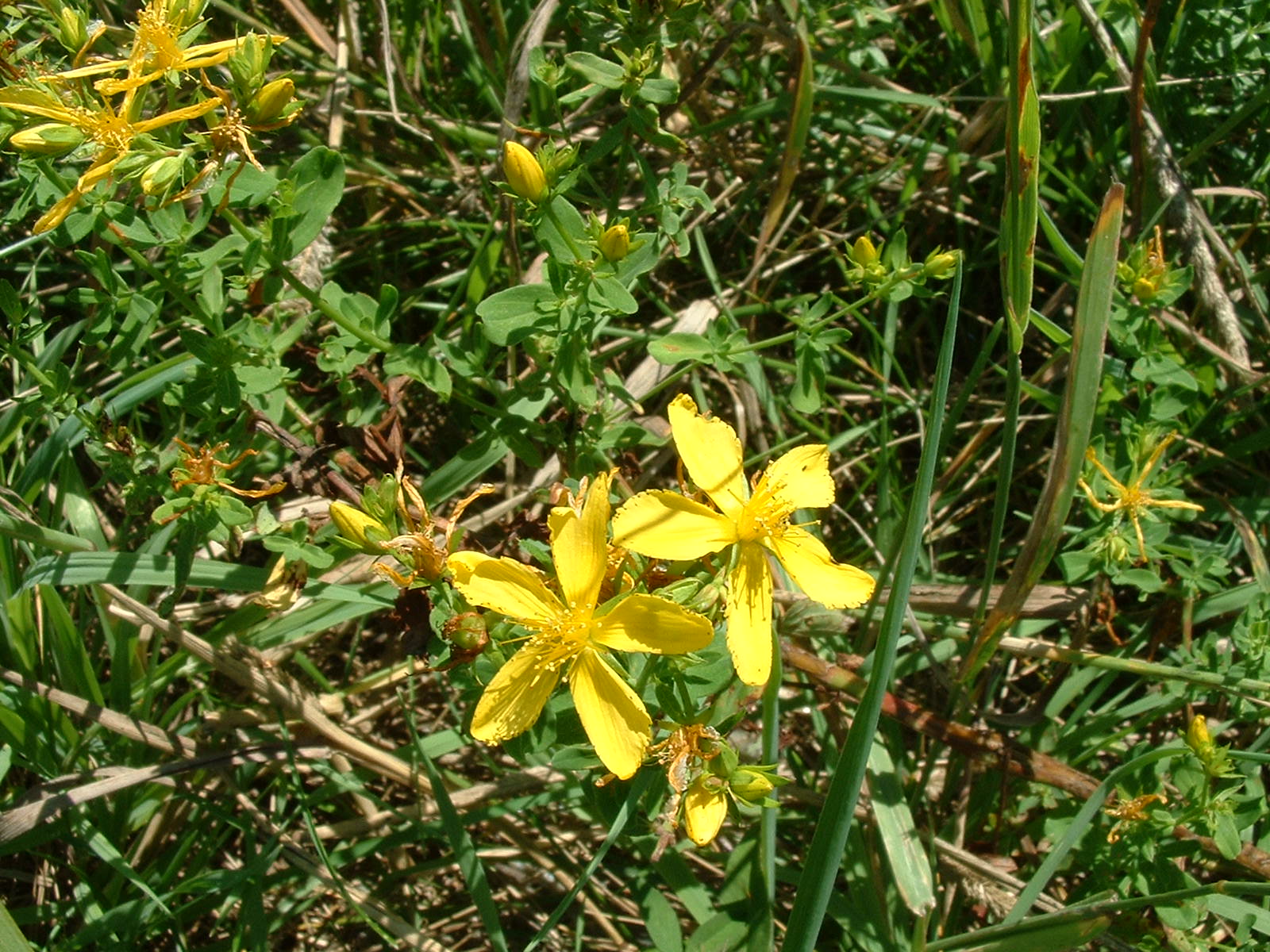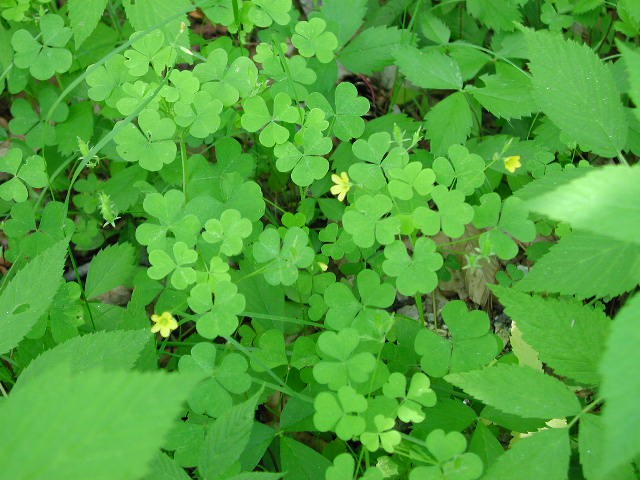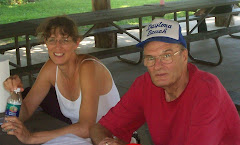
29. I didn't take the picture. Most of the
ST JOHN'S-WORT was done blooming shortly before I started this ID-ing venture. St John's-wort grows about knee-high along roads and in country ditches (aka, "disturbed soil") and usually begins blooming at the end of June ... in other words, about the time we celebrate the Nativity of John the Baptist. The sap is red, and if you crush or boil the yellow flowers they will become red/purple. This reminds us of the blood of the martyr. This pretty plant is the same St John's-wort used for treating depression.

30.
SWEET CLOVER is commonly seen along the highways and country roads, or unmowed locations in town (such as at the corner of highway off-ramps). I always thought "sweet clover" was an adjective describing the lovely smell of regular white clover that grows in your lawn. Nope. Sweet clover doesn't have a ball of flower. Rather, it looks almost feathery, usually growing at a height of about 3' and in airy-looking bunches. There's white sweet clover and yellow sweet clover, identical except for the color of the flowers. Most of the time, the sweet clover will wave above the surrounding grasses, but in this picture it's short enough to be partially obscured by the grass.

31. When you're zooming down the road at 60 mph,
WILD PARSNIP appears to be the yellow version of Queen Anne's Lace.

32.
MULLEIN is a biennial. The first picture here, with the rosette of soft soft fuzzy leaves is first-year growth. The second picture is the stalk that grows and flowers the following year.


33.
BIRD'S-FOOT TREFOIL is another legume (like peas or soybeans) with gorgeous flowers. You often see bird's-foot trefoil climbing out from a lawn, creeping over a concrete sidewalk. It frequently spills out from a lawn over the edge of the curb into the street. It's a bright bright yellow, and will "mound" a bit (like impatiens). If it gets into pasture-land, it supposedly makes good feed, like alfalfa. But I see it more often in town, dressing up lawns and sidewalks.

34. Before blooming,
YELLOW WOOD SORREL looks a lot like low hop clover. At least, they look a lot alike to an amateur like me. But the hop clovers and the sorrels aren't even in the same family, nor even in the same order. Hop clover flowers remain looking like little buds, whereas sorrels have the kind of flower that all first-graders like to draw -- a properly-petaled flower.
 30. SWEET CLOVER is commonly seen along the highways and country roads, or unmowed locations in town (such as at the corner of highway off-ramps). I always thought "sweet clover" was an adjective describing the lovely smell of regular white clover that grows in your lawn. Nope. Sweet clover doesn't have a ball of flower. Rather, it looks almost feathery, usually growing at a height of about 3' and in airy-looking bunches. There's white sweet clover and yellow sweet clover, identical except for the color of the flowers. Most of the time, the sweet clover will wave above the surrounding grasses, but in this picture it's short enough to be partially obscured by the grass.
30. SWEET CLOVER is commonly seen along the highways and country roads, or unmowed locations in town (such as at the corner of highway off-ramps). I always thought "sweet clover" was an adjective describing the lovely smell of regular white clover that grows in your lawn. Nope. Sweet clover doesn't have a ball of flower. Rather, it looks almost feathery, usually growing at a height of about 3' and in airy-looking bunches. There's white sweet clover and yellow sweet clover, identical except for the color of the flowers. Most of the time, the sweet clover will wave above the surrounding grasses, but in this picture it's short enough to be partially obscured by the grass. 31. When you're zooming down the road at 60 mph, WILD PARSNIP appears to be the yellow version of Queen Anne's Lace.
31. When you're zooming down the road at 60 mph, WILD PARSNIP appears to be the yellow version of Queen Anne's Lace. 32. MULLEIN is a biennial. The first picture here, with the rosette of soft soft fuzzy leaves is first-year growth. The second picture is the stalk that grows and flowers the following year.
32. MULLEIN is a biennial. The first picture here, with the rosette of soft soft fuzzy leaves is first-year growth. The second picture is the stalk that grows and flowers the following year. 
 33. BIRD'S-FOOT TREFOIL is another legume (like peas or soybeans) with gorgeous flowers. You often see bird's-foot trefoil climbing out from a lawn, creeping over a concrete sidewalk. It frequently spills out from a lawn over the edge of the curb into the street. It's a bright bright yellow, and will "mound" a bit (like impatiens). If it gets into pasture-land, it supposedly makes good feed, like alfalfa. But I see it more often in town, dressing up lawns and sidewalks.
33. BIRD'S-FOOT TREFOIL is another legume (like peas or soybeans) with gorgeous flowers. You often see bird's-foot trefoil climbing out from a lawn, creeping over a concrete sidewalk. It frequently spills out from a lawn over the edge of the curb into the street. It's a bright bright yellow, and will "mound" a bit (like impatiens). If it gets into pasture-land, it supposedly makes good feed, like alfalfa. But I see it more often in town, dressing up lawns and sidewalks. 34. Before blooming, YELLOW WOOD SORREL looks a lot like low hop clover. At least, they look a lot alike to an amateur like me. But the hop clovers and the sorrels aren't even in the same family, nor even in the same order. Hop clover flowers remain looking like little buds, whereas sorrels have the kind of flower that all first-graders like to draw -- a properly-petaled flower.
34. Before blooming, YELLOW WOOD SORREL looks a lot like low hop clover. At least, they look a lot alike to an amateur like me. But the hop clovers and the sorrels aren't even in the same family, nor even in the same order. Hop clover flowers remain looking like little buds, whereas sorrels have the kind of flower that all first-graders like to draw -- a properly-petaled flower.



No comments:
Post a Comment